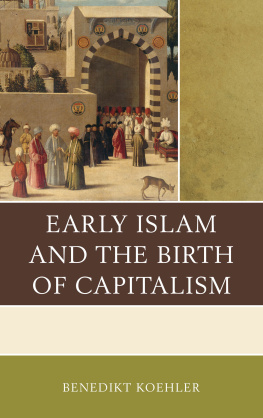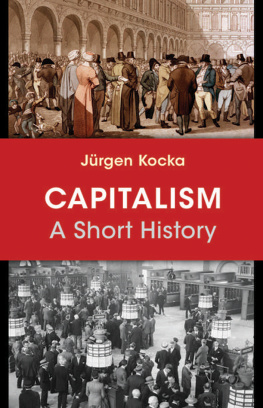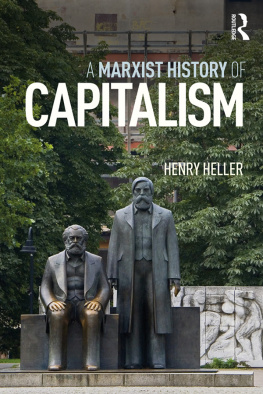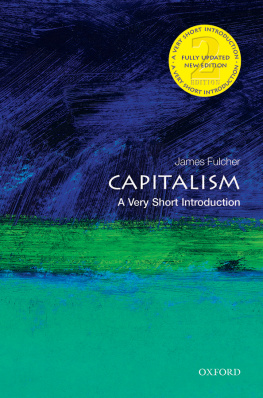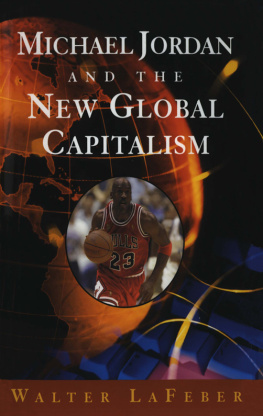Jairus Banaji - A Brief History of Commercial Capitalism
Here you can read online Jairus Banaji - A Brief History of Commercial Capitalism full text of the book (entire story) in english for free. Download pdf and epub, get meaning, cover and reviews about this ebook. year: 2020, publisher: Lightning Source Inc. (Tier 3), genre: Politics. Description of the work, (preface) as well as reviews are available. Best literature library LitArk.com created for fans of good reading and offers a wide selection of genres:
Romance novel
Science fiction
Adventure
Detective
Science
History
Home and family
Prose
Art
Politics
Computer
Non-fiction
Religion
Business
Children
Humor
Choose a favorite category and find really read worthwhile books. Enjoy immersion in the world of imagination, feel the emotions of the characters or learn something new for yourself, make an fascinating discovery.
- Book:A Brief History of Commercial Capitalism
- Author:
- Publisher:Lightning Source Inc. (Tier 3)
- Genre:
- Year:2020
- Rating:5 / 5
- Favourites:Add to favourites
- Your mark:
- 100
- 1
- 2
- 3
- 4
- 5
A Brief History of Commercial Capitalism: summary, description and annotation
We offer to read an annotation, description, summary or preface (depends on what the author of the book "A Brief History of Commercial Capitalism" wrote himself). If you haven't found the necessary information about the book — write in the comments, we will try to find it.
A Brief History of Commercial Capitalism — read online for free the complete book (whole text) full work
Below is the text of the book, divided by pages. System saving the place of the last page read, allows you to conveniently read the book "A Brief History of Commercial Capitalism" online for free, without having to search again every time where you left off. Put a bookmark, and you can go to the page where you finished reading at any time.
Font size:
Interval:
Bookmark:
2020 Jairus Banaji
Published in 2020 by
Haymarket Books
P.O. Box 180165
Chicago, IL 60618
773-583-7884
www.haymarketbooks.org
info@haymarketbooks.org
ISBN: 978-1-64259-211-5
Distributed to the trade in the US through Consortium Book Sales and Distribution (www.cbsd.com) and internationally through Ingram Publisher Services International (www.ingramcontent.com).
This book was published with the generous support of Lannan Foundation and Wallace Action Fund.
Special discounts are available for bulk purchases by organizations and institutions. Please call 773-583-7884 or email info@haymarketbooks.org for more information.
Cover photograph: Panoramic view of Istanbul and the Golden Horn taken from the top of Seraskier (or Beyazit) Tower by the Swedish photographer Guillaume Berggren ca. 1870.
Cover design by Jamie Kerry.
Library of Congress Cataloging-in-Publication data is available.
For Henry, Javed, M. J., and Sughosh
The Infrastructure of Commercial Capitalism
Trading Colonies
The dispersion of networks was a major instrument of capital accumulation. If the characteristic mobility of capital is what Marx calls circulation, then for centuries the circulation of capital presupposed the physical movement of commercial agents, which in turn would mean their ability to establish more or less stable settlements in locations abroad. The term for such a settlement was factory. Factory according to Dr. Johnson means a house or district inhabited by Traders in a distant country.
The history of commerce is thus a rich tapestry of trading colonies that spanned the entire globe, wherever this was accessible. In Guangzhou (Canton) in the later eleventh century, The foreign ward ( fanfang ) is where those from various countries from across the ocean congregate and live. (Ibn Jubayr also claims that they do not congregate for the Friday service, since the khutbah is forbidden.)
In Tunis, a suburb outside the eastern or Sea gate (the Bab el-bahr) was the home of Italian and Catalan merchants in the early sixteenth century.
Finally, between the Mediterranean and China were ports like Sohar, Masqat, Calicut, and Malacca, all of which had substantial settlements of foreign traders. Sohar, on the edge of the Indian Ocean and the only town in Oman with any real urban development, was closely linked with the Omani overseas community living in Basra.
What was so striking about Calicut was the more or less stable presence of a substantial colony of foreign merchants from Cairo and the Red Sea ports as well as other parts of the Middle East from as early as the fourteenth century.
East of Malabar, Malacca was the richest seaport with the greatest number of wholesale merchants and abundance of shipping and trade.
Of course, trading colonies were not confined to port cities and were found in major inland centers as well. Isfahan in the 1640s was said to have a large number of strangers who usually frequent this Persian Emporium on account of its flourishing trade and commerce. The Portuguese monk Manrique claimed that more than six hundred caravanseries exist for these foreigners.
Wholesale Markets
Wholesale markets with a global reach are attested in various sources from the seventh to the tenth centuries. Reir i Parsan , from which come fine pearls was how an Armenian geographer described one market of this sort in the seventh century, referring to Rishahr on the southern coast of Iran. and Barus in the far north of Sumatra was where merchants went to buy camphor.
By the twelfth century Ceuta was another major center of the coral trade. Al-Idrisi tells us it had a market where one cuts and polishes the coral and makes jewellery out of it. This was widely exported, the bulk of it to Ghana and the Sudan.
Flax and spices were likewise wholesale trades dominated by medieval Alexandria. In the late eleventh century, it exported between five to six thousand tons of raw flax to markets in the Mediterranean,
Danzig was a major grain market with massive shipments to the Iberian Peninsula. Almost eighty thousand tons passed through the town in 1562.
In Cairo the coffee trade involved some five hundred merchants importing roughly one hundred thousand quintals, of which half was reexported to markets in the Ottoman empire.
In the second half of the sixteenth century most Iranian raw silk was traded in Aleppo. The wholesalers were Armenian merchants who recirculated the silver acquired from European buyers to finance purchases of high-quality indigo in the wholesale markets of Agra and Bayana.
Salonica was described as the great mart for tobacco in the Levant.
Wholesale markets were as important as ever in the nineteenth century, which saw a new proliferation of commercial capitals as industrial accumulation massively increased the demand for industrial crops like cotton, silk, palm oil, teak, jute, and rubber, and for mass consumption goods like tea, coffee, sugar, cocoa, rice, wheat, and so on. The volume of international trade grew fivefold in the central decades between 1840 and 1870. Like the biggest merchant capitals everywhere, the export firms were resentful of their dependence on the middlemen (the acopiadores ) and sought to establish their own offices and agents in the Buenos Aires wheat zone, which only deepened tensions between the local grain merchants and the Big Four.
Wholesale markets had always been characterized by a degree of specialization but in the nineteenth century this became more obvious than ever. Beirut was defined by its exports of raw silk, Alexandria of cotton, Karachi of wheat, Rangoon of rice, Foochow of tea. The tea business in Foochow was generally on a grand scale .
Bills of Exchange
In addition to bank notes, wholesale trade has a second and far more important means of circulation: bills of exchange, Marx writes in volume three of Capital .
Bills of exchange were widely used in Venetian trade in the Levant. then those fairs, dominated by a club of some sixty bankers, show us how advanced the financial markets still were under Italian (in this case, Genoese) dominance.
However, by the sixteenth century bills of exchange were widely used in the Ottoman empire as well (where they were called suftajas )
The eighteenth century was when bills of exchange came into circulation in a big way. Charles Carrire describes the bill of exchange as the perfect instrument of commercial capitalism in the eighteenth century.
Sterling-denominated bills drawn on London became the pivot around which international trade revolved by the main part of the nineteenth century. Liquidity was the key here, fueling massive commercial expansion. The City became a short-term money market of unrivalled liquidity and security,
The truly important innovation in the first fifteen years of the nineteenth century was the emergence of the manufacturer who exported directly to distant markets. In consigning exports on their own account , with the assistance of Liverpool and foreign-based commission agents who in turn relied on the London acceptance houses, these British cotton manufacturers were the first signs, historically, of what Marx would later call the subordination of commercial to industrial capital. Marx himself telescoped this process massively, projecting it back to a much earlier period, whereas in fact even in the nineteenth century commercial capital remained largely dominant down to the later decades of the century when an entirely new breed of industrial capital, the capital-intensive vertically integrated firms, would finally emerge to eliminate the old-style merchants by organizing their own sales networks.
The Competition of Capitals
Struggles for Commercial Dominance from the Twelfth to Eighteenth Centuries
Byzantium: The Subordination of Greek Capital
Next pageFont size:
Interval:
Bookmark:
Similar books «A Brief History of Commercial Capitalism»
Look at similar books to A Brief History of Commercial Capitalism. We have selected literature similar in name and meaning in the hope of providing readers with more options to find new, interesting, not yet read works.
Discussion, reviews of the book A Brief History of Commercial Capitalism and just readers' own opinions. Leave your comments, write what you think about the work, its meaning or the main characters. Specify what exactly you liked and what you didn't like, and why you think so.




